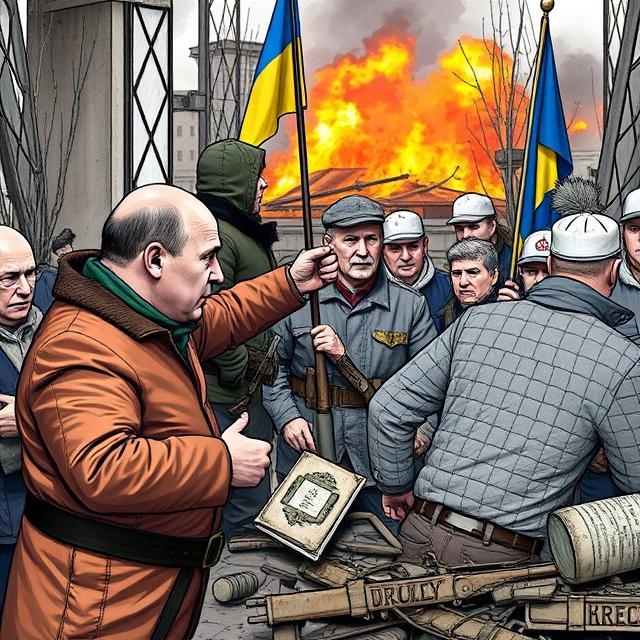Introduction
The Russia-Ukraine conflict has emerged as one of the most significant geopolitical crises of the 21st century, reshaping global politics and security dynamics. Rooted in a complex mix of historical grievances, territorial disputes, political tensions, and international rivalries, the conflict has had far-reaching consequences. Understanding the underlying causes requires an examination of historical, political, economic, and strategic factors that have contributed to the tensions between these two nations.
1. Historical Context and Soviet Legacy
The historical relationship between Russia and Ukraine has played a crucial role in shaping the conflict. Ukraine was part of the Russian Empire for centuries and later became a Soviet republic within the USSR (Union of Soviet Socialist Republics). Although Ukraine gained independence in 1991 after the Soviet Union’s collapse, Russia has continued to view Ukraine as part of its strategic and cultural sphere of influence.
Key historical factors include:
- Kievan Rus’ and Russian Identity: Russia traces its cultural and political origins to Kievan Rus’, an early medieval state centered in present-day Ukraine.
- Soviet Union and Russification: During the Soviet era, Ukraine was subjected to Russification policies that aimed to integrate Ukrainian culture with Russian identity.
- Post-Soviet Struggles: The dissolution of the Soviet Union in 1991 led to new national boundaries, with Russia and Ukraine inheriting unresolved disputes.
2. Annexation of Crimea (2014)
One of the major turning points in Russia-Ukraine relations was Russia’s annexation of Crimea in 2014. This event marked the beginning of heightened tensions and international sanctions against Russia. The key causes of the Crimea crisis include:
- Pro-Russian Sentiment in Crimea: A significant portion of Crimea’s population is ethnically Russian and supported closer ties with Moscow.
- Strategic Importance of Crimea: Russia’s Black Sea Fleet is based in Crimea, making it a critical geopolitical asset.
- Ukrainian Euromaidan Protests: The ousting of Ukraine’s pro-Russian President Viktor Yanukovych in 2014 triggered Russia’s intervention in Crimea.
- Unrecognized Referendum: Russia conducted a referendum in Crimea, which resulted in a controversial vote to join Russia, widely condemned by Ukraine and the West.
3. NATO Expansion and Western Influence
Russia has consistently opposed NATO’s eastward expansion, viewing it as a direct threat to its security. The possibility of Ukraine joining NATO has been one of the key triggers of the conflict. Russia’s concerns include:
- Encroachment on Russia’s Borders: Russia sees NATO expansion as an attempt to contain and weaken its influence.
- Western Support for Ukraine: The West, particularly the United States and the European Union, has supported Ukraine through military aid, economic assistance, and diplomatic backing.
- Russia’s Demand for Security Guarantees: Russia has repeatedly demanded assurances that Ukraine would not join NATO, which the West has not fully accepted.
4. Separatist Movements in Eastern Ukraine
The conflict intensified in 2014 with the outbreak of violence in eastern Ukraine, where pro-Russian separatists declared independence in Donetsk and Luhansk regions. The causes of separatist tensions include:
- Ethnic and Linguistic Divisions: Eastern Ukraine has a large Russian-speaking population that has historically had closer ties to Russia.
- Russian Support for Separatists: Russia has provided military, financial, and logistical support to separatist groups, leading to prolonged fighting.
- Failure of the Minsk Agreements: Peace efforts through the Minsk Agreements failed due to violations by both sides, prolonging the hostilities.
5. Economic and Energy Disputes
Economic factors have also played a significant role in the conflict. Ukraine has been a key transit country for Russian natural gas exports to Europe, leading to disputes over pricing, supply, and transit fees.
- Gas Wars: Russia has cut gas supplies to Ukraine multiple times due to disputes over payment and contracts.
- Ukraine’s Shift Towards European Energy Markets: Ukraine has sought to reduce its dependency on Russian gas by diversifying its energy sources.
- Sanctions and Economic Impact: Western sanctions against Russia have impacted its economy, but Russia has adapted by strengthening economic ties with China and other non-Western nations.
6. Geopolitical Rivalries and Global Power Struggle
The conflict is not just a regional issue but a manifestation of larger geopolitical rivalries between Russia and the West. Key aspects of this global power struggle include:
- U.S. and EU Involvement: Western nations have supported Ukraine through military aid, sanctions on Russia, and diplomatic pressure.
- China’s Position: While China has maintained a neutral stance, it has deepened its economic and strategic ties with Russia.
- Emergence of a New Cold War: The conflict has reignited tensions reminiscent of the Cold War, with increased military buildups and ideological divisions.
7. Ideological and Political Differences
The political trajectories of Russia and Ukraine have diverged significantly since the fall of the Soviet Union.
- Ukraine’s Democratic Aspirations: Ukraine has pursued closer ties with Europe, democratic governance, and economic reforms.
- Russia’s Authoritarian Model: Russia, under Vladimir Putin, has sought to maintain a strong centralized authority and resist Western-style democracy.
- Battle of Influence: The conflict is also a struggle over the future political orientation of Ukraine – whether it aligns with the West or remains under Russian influence.
8. Immediate Triggers of the 2022 Invasion
The full-scale invasion of Ukraine by Russia in 2022 was driven by several immediate factors:
- Russia’s Recognition of Donetsk and Luhansk: Russia officially recognized the independence of the separatist regions, justifying military action.
- Military Build-up and Escalation: Russia amassed troops along Ukraine’s borders before launching a large-scale attack.
- Ukraine’s Resistance and Western Response: Ukraine’s determination to resist Russian aggression and the West’s promise of support fueled Moscow’s aggressive stance.
Conclusion
The Russia-Ukraine conflict is rooted in a combination of historical grievances, geopolitical rivalries, economic disputes, and ideological differences. While the immediate triggers include Russia’s recognition of separatist regions and Ukraine’s push for NATO membership, the deeper causes lie in centuries of territorial disputes and shifting alliances. The war has had devastating humanitarian consequences and has reshaped global security dynamics. Moving forward, diplomatic efforts, international negotiations, and strategic compromises will be essential in resolving this complex and evolving crisis.




